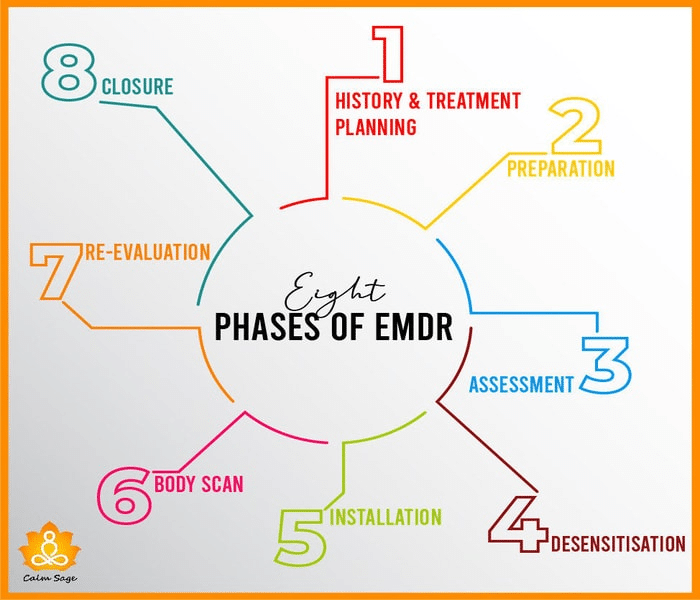Let’s explore EMDR, a powerful trauma treatment. We’ll discuss its different phases and uncover the aspects of this effective method if you’ve ever been curious about the involved procedures.
EMDR therapy was found to be faster and/or more effective than trauma-focused cognitive behavioral therapy in 7 out of 10 investigations.
Let’s explore a more sophisticated knowledge of how EMDR reveals its healing potential, from assessment to reprocessing.
Understanding trauma
We start by peeling back the infinite layers of trauma. This is a journey that calls for bravery, resiliency, and most importantly, a desire to heal. This blog will explore how trauma affects mental health and discuss ways to understand and achieve healing.
Let’s start by defining trauma: it is an experience that creates a permanent mark on our bodies and minds, not just an event. Because trauma is subjective and varies from person to person, it is important to approach it with empathy and compassion.
The effects of trauma persist long after the initial event and frequently show up as mental health disorders like depression, anxiety, and PTSD. It’s important to grasp these effects to understand the urgent need for effective therapeutic interventions.
Understanding the use case of EMDR phases
Before diving into the 8 phases of EMDR, we evaluate some of the important causes that can inculcate trauma in an individual:
- Mishaps: Traumatic events can result from sudden and unexpected events like car accidents or incidents at work.
- Maltreatment: Whether it occurs in childhood or adulthood, physical, emotional, or sexual abuse can leave lasting emotional wounds.
- Natural Catastrophes: Natural disasters such as hurricanes, floods, earthquakes, or wildfires can cause trauma because of the unexpected disruption and loss they cause.
- Losing a Close Relative: A close friend, family member, or partner passing away can cause severe trauma and grief.
- Warfare and Combat: Serving in the military and being around combat zones can cause trauma, which frequently results in disorders like PTSD.
- Trauma Medical: Medical emergencies, major illnesses, and surgeries can all be traumatic, particularly if they entail excruciating pain or potentially fatal circumstances.
- Bullying: Persistent bullying can result in long-lasting psychological trauma whether it occurs online, at work, or in schools.
- Localized Violence: Experiencing violence in your community, like crime or being part of gangs, can make trauma worse.
- Abrupt or Forceful Occurrences: Trauma can result from incidents like physical assaults, break-ins, and witnessing violent crimes.
- Discrimination and Anger Management: Chronic stress and trauma can arise from encountering discrimination based on race, gender, sexual orientation, or other factors.
What are the 8 stages of EMDR?

In treating trauma, EMDR therapy has even been shown to be more effective than Prozac. According to Shapiro and Forrest (2016), since 2016, 110,000 therapists have successfully treated over 7 million patients across 130 countries.
Here are 8 phases of EMDR that are meant to be followed in the same manner as mentioned:
Phase 1: Planning Treatment and Taking History
The aim is to establish a therapeutic relationship while collecting data.
The therapist thoroughly evaluates the client’s past, taking into account any traumatic experiences, present symptoms, and coping mechanisms.
The client and the therapist work together to create an EMDR therapy treatment plan and set goals.
Phase 2: Get Ready
During this phase, the therapist provides coping mechanisms to help the client prepare for the next stages of processing. The therapist explains the EMDR process and what to expect in each session. We introduce coping methods, like stress reduction techniques, to help the client feel prepared for the emotional processing that awaits them.
Phases 3–6: Handling Memories of Trauma
Reprocess and desensitize the specific traumatic memories.
Target memory identification: The client and the therapist collaborate to pinpoint particular memories associated with the traumatic incident.
Desensitization: The client focuses on a known memory while getting stimulation on both sides simultaneously, often through tapping, sounds, or guided eye movements.
Installation of positive beliefs: Negative beliefs connected to the traumatic memory are replaced with positive thoughts.
Phases 7-8: Body Scan and Installation
Solidify constructive thoughts and guarantee that any lingering physical pain is resolved.
Installation of positive beliefs: To displace negative beliefs, positive beliefs that were discovered in previous phases are strengthened and reinforced.
Closure: Before ending each session, the therapist makes sure the client is in a balanced state.
Reevaluation: Reassessing earlier work and addressing any lingering trauma-related issues may be part of later sessions.
During the processing process, clients are welcome to investigate ideas, feelings, and experiences.
Adaptive Information Processing (AIP) Model: The therapist works to improve the client’s ability to process information related to the trauma while continuously keeping in mind the client’s general well-being.
Role of EMDR phases
Therapeutic Alliance Create a solid, dependable therapeutic alliance. Spend time getting to know the client’s past, traumatic experiences, and present-day symptoms. This establishes the framework for individualized care.
Psychoeducation: As you explain the EMDR process, make sure the client knows what to anticipate. Respond to any worries or inquiries they might have.
Adaptive Techniques: Instruct coping mechanisms and stress reduction to help with emotional control. Make sure the client has resources at their disposal to handle stress both in and out of sessions.
Working together with the client to pinpoint particular target memories associated with upsetting experiences can help them know themselves better.
Set priorities and choose targets that have a major impact on the symptoms the client is experiencing.
Introduce bilateral stimulation, such as taps, sounds, or eye movements. Assist the client in reprocessing the traumatic memory by emphasizing feelings, ideas, and bodily sensations.
Positive ideas should be introduced to replace negative thoughts. Reiterate self-affirmations that are constructive and resilient.
Take care of any emotional pain that persists.
Strengthen your positive beliefs even more. Strengthen the incorporation of flexible ideas. Methodically end the meeting.
Make sure the client feels centered and secure. Encourage the use of coping mechanisms to control emotions after the session.
Review the development that has occurred in the next sessions. Determine if there are any lingering symptoms of trauma.
Determine whether more processing is required.
FAQs
1. What is the role of bilateral stimulation in EMDR?
An essential part of Eye Movement Desensitization and Reprocessing (EMDR) treatment is bilateral stimulation. It makes use of rhythmic, repetitive stimuli, like tapping on the skin, tones in the voice, or side-to-side eye movements. Bilateral stimulation is mainly used to assist in processing and desensitizing traumatic memories.
2. How long does each EMDR session typically last?
The average length of an EMDR session is sixty to ninety minutes. The duration of the session enables careful planning, processing of the memories that are of interest, and a fitting conclusion to guarantee that the client feels rooted before departing. Adjusting the session length is possible based on the client’s comfort level and the progress achieved.
3. Can EMDR be effective for single-incident traumas?
Yes, for traumas resulting from a single incident, Eye Movement Desensitization and Reprocessing (EMDR) can be quite beneficial. EMDR has been extensively studied and proven to be helpful for various traumatic experiences. It is particularly well-suited for addressing single-incident traumas. Events like auto accidents, assaults, natural disasters, or other sporadic upsetting incidents may fall under this category.
4. How do I find a qualified EMDR therapist?
- Make use of online directories for therapists, like the one maintained by the EMDR International Association (EMDRIA), Psychology Today, or GoodTherapy. You can frequently look for therapists using these platforms by selecting criteria like specialization, location, and type of treatment.
- Ask friends who have had successful therapy experiences, mental health professionals, or your primary care physician for recommendations. Personal recommendations can offer insightful information.
- Speak with the hospitals, clinics, or mental health organizations in your area. They can make recommendations and frequently keep lists of licensed therapists in the region.
- Arrange for initial consultations with prospective therapists to talk about your needs, find out about their background in EMDR, and determine whether or not you feel comfortable working with them. In order to guarantee a good therapeutic fit, this step is essential.
Conclusion
As we conclude our examination of the “8 Phases of EMDR,” it is clear that this therapy strategy provides a thorough and organized way to confront and resolve trauma. In the beginning, we create a personalized and client-focused process. This process includes planning the treatment and reviewing the client’s history. In the next stages, we identify memories for reprocessing and create a safe therapeutic environment. These stages involve preparation and assessment.
Essentially, the eight stages of EMDR offer a road map for negotiating the intricacies of trauma, assisting people in reaching a more complete and harmonious state of being. This therapeutic approach actively works with the effects of prior events, acknowledging their influence and facilitating the transformation of distressing and negative thoughts into narratives that are empowering and adaptable. With this procedure, EMDR becomes a potent instrument in the field of trauma-focused treatment, providing healing and hope to individuals pursuing recovery.
Depending on the extent of care needed, Relevance Recovery offers additional techniques in addition to EMDR to treat a range of mental health conditions. They provide integrated, multidisciplinary, holistic treatment for mental health issues and drug abuse.



















